Serving 632 students in grades Kindergarten-5, Fall Brook ranks in the top 30% of all schools in Massachusetts for overall test scores (math proficiency is top 30%, and reading proficiency is top 30%).
The percentage of students achieving proficiency in math is 58% (which is higher than the Massachusetts state average of 41%). The percentage of students achieving proficiency in reading/language arts is 53% (which is higher than the Massachusetts state average of 44%).
The student:teacher ratio of 14:1 is higher than the Massachusetts state level of 12:1.
Minority enrollment is 51% of the student body (majority Hispanic), which is higher than the Massachusetts state average of 47% (majority Hispanic).
Quick Stats (2025)
- Grades: Kindergarten-5
- Enrollment: 632 students
- Student:Teacher Ratio: 14:1
- Minority Enrollment: 51%
- Overall Testing Rank: Top 30% in MA
- Math Proficiency: 58% (Top 30%)
- Reading Proficiency: 53% (Top 50%)
- Science Proficiency: 50-54% (Top 50%)
- Source: National Center for Education Statistics (NCES), MA Dept. of Education
Top Rankings
Fall Brook ranks among the top 20% of public schools in Massachusetts for:
Category
Attribute
Most improved public schools
Diversity
School Overview
Fall Brook's student population of 632 students has stayed relatively flat over five school years.
The teacher population of 45 teachers has stayed relatively flat over five school years.
Grades Offered
Grades Kindergarten-5
(offers virtual instruction)
(offers virtual instruction)
Total Students
632 students
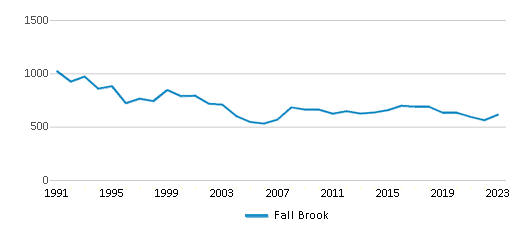
Gender %
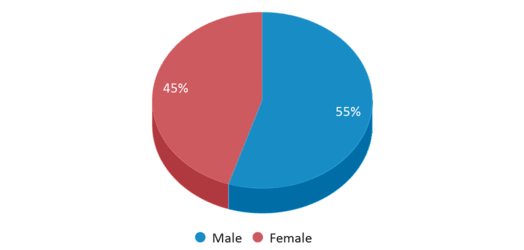
Total Classroom Teachers
45 teachers
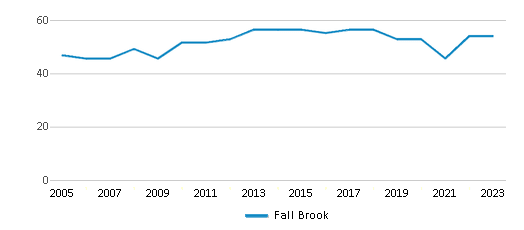
Students by Grade
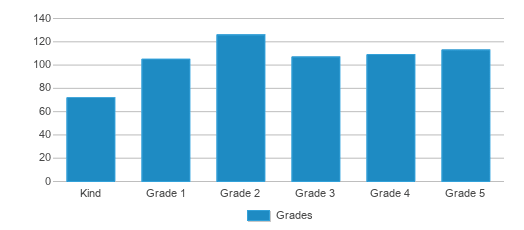
School Rankings
Fall Brook ranks within the top 30% of all 1,631 schools in Massachusetts (based off of combined math and reading proficiency testing data).
The diversity score of Fall Brook is 0.64, which is less than the diversity score at state average of 0.65. The school's diversity has stayed relatively flat over five school years.
Overall Testing Rank
#436 out of 1631 schools
(Top 30%)
(Top 30%)
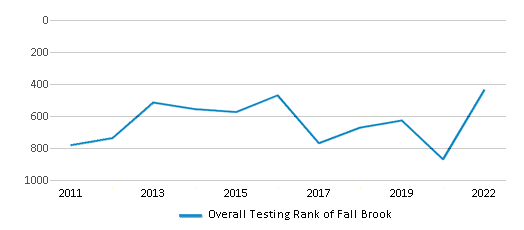
Math Test Scores (% Proficient)
58%
41%

Reading/Language Arts Test Scores (% Proficient)
53%
44%
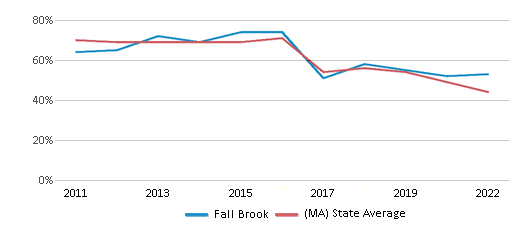
Science Test Scores (% Proficient)
50-54%
44%
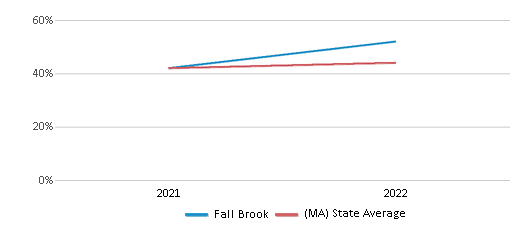
Student : Teacher Ratio
14:1
12:1
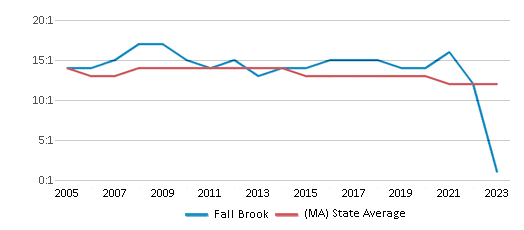
American Indian
n/a
n/a
Asian
3%
7%

Hispanic
34%
25%
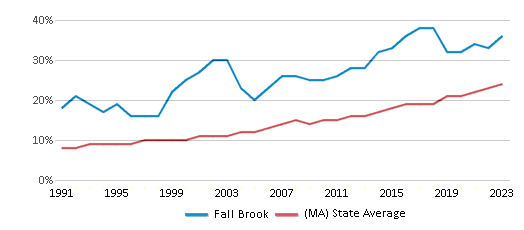
Black
9%
10%

White
49%
53%
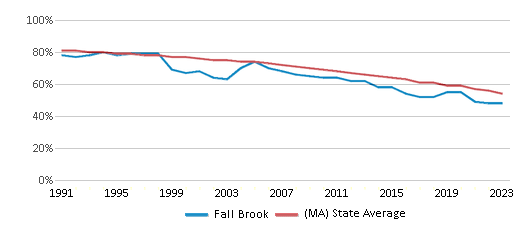
Hawaiian
n/a
n/a
Two or more races
5%
5%
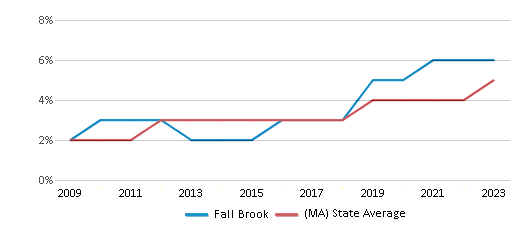
All Ethnic Groups
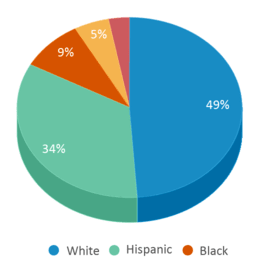
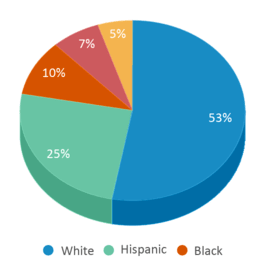
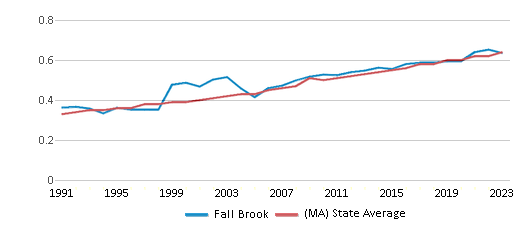
Participates in the National School Lunch Program (NSLP)
Yes
Eligible for Free Lunch
43%
35%
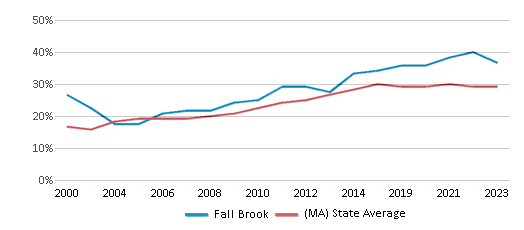
Eligible for Reduced Lunch
5%
4%
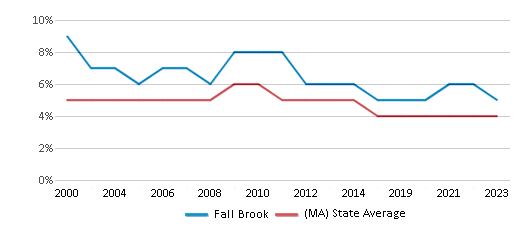
School Statewide Testing
School District Name
Source: National Center for Education Statistics (NCES), MA Dept. of Education
Profile last updated: 02/09/2025
Frequently Asked Questions
What is Fall Brook's ranking?
Fall Brook is ranked #436 out of 1,631 schools, which ranks it among the top 30% of public schools in Massachusetts.
What schools are Fall Brook often compared to?
Fall Brookis often viewed alongside schools like Johnny Appleseed by visitors of our site.
What percent of students have achieved state testing proficiency in math and reading?
58% of students have achieved math proficiency (compared to the 41% MA state average), while 53% of students have achieved reading proficiency (compared to the 44% MA state average).
How many students attend Fall Brook?
632 students attend Fall Brook.
What is the racial composition of the student body?
49% of Fall Brook students are White, 34% of students are Hispanic, 9% of students are Black, 5% of students are Two or more races, and 3% of students are Asian.
What is the student:teacher ratio of Fall Brook?
Fall Brook has a student ration of 14:1, which is higher than the Massachusetts state average of 12:1.
What grades does Fall Brook offer ?
Fall Brook offers enrollment in grades Kindergarten-5 (offers virtual instruction).
What school district is Fall Brook part of?
Fall Brook is part of Leominster School District.
School Reviews
5 3/16/2020
I have been the parent of a child going to Fallbrook for 3 years. He has had 3 very different teachers, all were great and went above and beyond teaching; As they all have to. My son has learned to read, do math like a 6th grader, and there are awesome music and art classes with fun projects and concerts at least once a year. The office all call my son by his first name since the first year of school. They are always there to answer any questions and have been trained to deal with all sorts of situations that arise in the first years of a child going to school. Some kids are going to school after never being around many or any kids their age. That alone brings kids that are scared, nervous, angry, hyper and some act on it. It is going to happen and the faculty at Fallbrook are really wonderful at dealing with every type of issue the kids and the parents of these kids have. I give them 5 stars for my experience so far. I've been called or messaged whenever something comes up that needs to be worked on at home as well as at school. Thank you, Fallbrook. I have seen all you do for the kids. And appreciate you all!
2 9/6/2010
My daughter was about to enter her 1st grade year at this school when we found out she was placed in an inclusion class with a student that bit her the year before. We reached out to the principal for assistance in having our daughter moved to a new class and she refused. She did not care how my wife, I, or our daughter felt about the situation and responded No to our request immediately on reading it. We were then forced to take matters into our own hands to ensure our daughter's safety and move her to private school..
Review Fall Brook. Reviews should be a few sentences in length. Please include any comments on:
- Quality of academic programs, teachers, and facilities
- Availability of music, art, sports and other extracurricular activities
Recent Articles

What Is A Charter School?
Explore the world of charter schools in this comprehensive guide. Learn about their history, how they operate, and the pros and cons of this educational innovation. Discover key facts about charter schools, including admission policies, demographics, and funding, as well as what to look for when considering a charter school for your child.

10 Reasons Why High School Sports Benefit Students
Discover the 10 compelling reasons why high school sports are beneficial for students. This comprehensive article explores how athletics enhance academic performance, foster personal growth, and develop crucial life skills. From improved fitness and time management to leadership development and community representation, learn why participating in high school sports can be a game-changer for students' overall success and well-being.

February 05, 2025
Understanding the U.S. Department of Education: Structure, Impact, and EvolutionWe explore how the Department of Education shapes American education, from its cabinet-level leadership to its impact on millions of students, written for general audiences seeking clarity on this vital institution.









